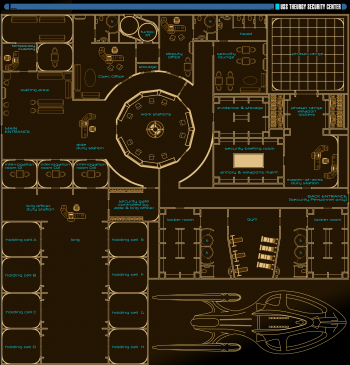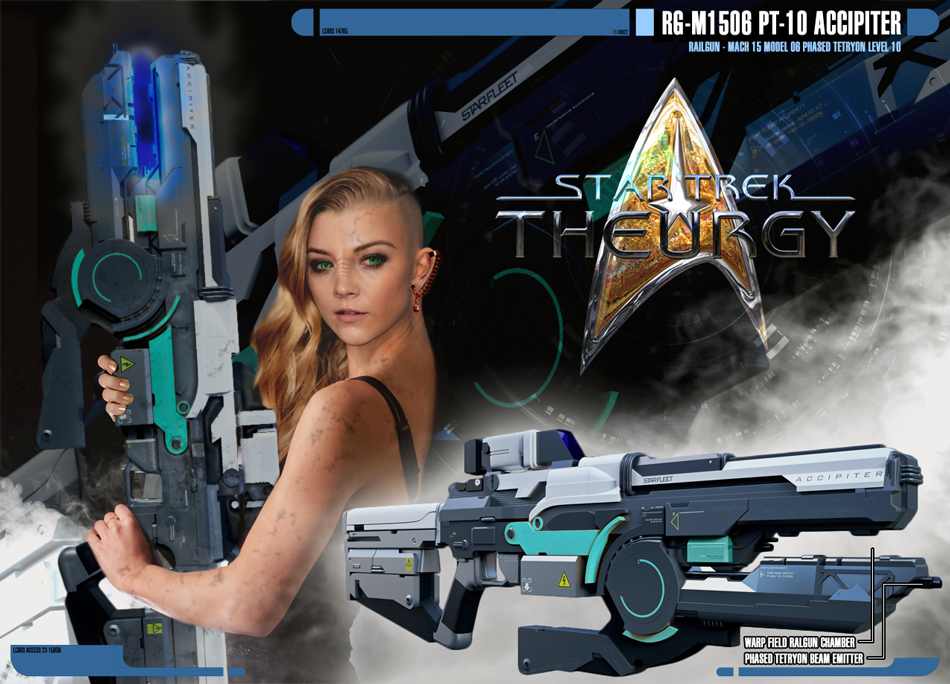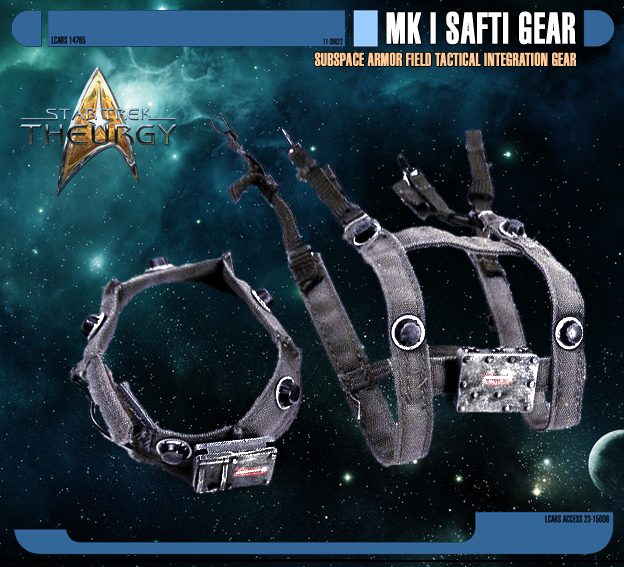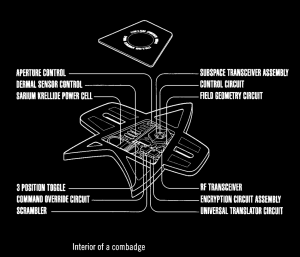Security
From Star Trek: Theurgy Wiki
Starfleet Security is one of the oldest institutions with its origins dating back to Earth Starfleet, responsible for safeguarding the Federation from internal and external threats, for conducting criminal investigations, and for guarding Federation facilities. [Source: Memory Alpha]
Starfleet Security is also the armed special forces of the fleet. Duties range from putting yourself between a phaser and the Commanding Officer of the ship, patrolling the ship for endless hours and even engaging hostile threats upon uncharted planetoids.
To be a member of Starfleet Security, one needs the ability to foresee a problem and avert it. To be able to think on one's feet to figure out a decisive, effective solution to the situation at hand. A Security Officer has to have an understanding of the scenario and the people involved, knowing the problem s/he is dealing with inside and out. S/he must be prepared to use force to neutralize any and every threat, but only use it as a last resort. S/he is protective of ship and crew, and must defend both to to their last breath.
Standing Orders
All Security Officers are at all times responsible for carrying out standing orders. Standing orders are permanent, unless cancelled by the CSec.
Aims & Directives
- To preserve the integrity of the ship against intrusion and insurrection.
- To provide protection for landing parties entering unexplored or hazardous territory.
- To act in concert with Damage Control and Medical personnel in seeking out and rescuing personnel trapped in hazardous areas or missing in action.
- To ensure the safety of visiting dignitaries.
- To provide armed escort for Flag and Senior Officers venturing into hazardous territory.
- To serve as an honour guard as designated.
- To ensure the integrity of restricted areas of the ship against entry by unauthorized personnel.
- To provide a first-line strike force for boarding hostile vessels.
- To oversee transfer and/or confinement of persons under legal arrest or in custody.
- To act as bailiffs for onboard legal proceedings.
- To oversee the safe and orderly proceedings of any partial evacuation of the ship, or to aid in the full abandonment of the ship.
- To serve as a rescue force for any crewmember or citizen of the United Federation of Planets who is incarcerated or held hostage illegally by any hostile power and/or government.
- To effectively intervene in intra-crew disputes, or in disputes between crewmembers and civilians.
- To ensure the observance of applicable Starfleet Directives by civilian personnel on Starfleet vessels or facilities.
- To ensure peaceful contact by all parties in Starfleet and Federation supervised negotiations
- To maintain alertness at post or duties until such time as relieved by qualified personnel.
Duties & Responsibilities
- To obey all directions and orders given by the Ship's Commanding Officer, Executive Officer, Second Officer, the Chief of Security, the Deputy Chief of Security and other line officers of higher than Ensign rank, in that descending order.
- To work smoothly and efficiently with assigned officers on your duty shift.
- To avoid the consumption of any substance of a mood-altering nature during a period of 8 hours before scheduled to go on-duty.
- Weapons shall be worn at all times while on duty.
- Weapons shall be set on Medium Stun unless otherwise ordered by an officer in the line of command, or unless the ship is on Condition 4, or unless special circumstances pertain making Medium Stun ineffectual or undesirable.
- In hazardous territory or under perilous circumstances, weapons shall be drawn or be ready to be drawn at all times.
- Under normal circumstances, weapons shall not be drawn unless danger to life or limb is apparent an imminent.
- If a weapon is damaged or lost, the fact must be passed to the Master-at-Arms at once.
During Sentry & Patrol Duties
- To take charge of the assigned post and all areas in view.
- To guard the post in a military manner, keeping always on the alert and observant of everything.
- To report all violations of Special or Standing Orders.
- To maintain communication with the aide in the Security Office.
- To receive, obey, and pass on to other relieving personnel any Special Orders received by the CSec or Deputy.
- To talk to no one except in the line of duty.
- To sound the alert in case of danger or disorder.
- To call the Csec or Deputy in any case not covered by instructions.
Brief Duty Protocols
There are three types of duties a Security Officer will undertake - General Duties, Special Duties, and Ceremonial Duties.
General Duties
Patrol: A Security Officer or team of two will patrol throughout the ship. They will receive their routes from the CSec or Deputy at the beginning of their shift, in the Security Office. This route will be computer generated, striving for both random pattern and minimum redundancy. There are two basic reasons for this; it reduces the element of boredom inherent in the nature of patrolling (and thus minimizes errors caused by fatigue), and it eliminates the possibility of a spy or saboteur scheduling his activities safely according to an observed pattern. A regular check-in with the Aide in the Security Office is required every 15 minutes.
If a suspicious circumstance is observed, one must contact the Csec or Deputy first before taking action. Phaser is then drawn, setting checked, and one must approach quietly and cautiously. If there are two Security Officers, one will move in, and one will cover him. On final approach to the suspicious area, remember the unofficial rule of patrols: "Shoot first and apologize later". A phaser set on Medium Stun cannot cause permanent injury, and it is better to be safe than sorry. It is preferable that an innocent officer or crewman take an unscheduled nap than that the safety of the entire vessel be endangered. Otherwise, review "Sentry & Patrol Duties" above.
Armoury: The Armoury is the Master-at-Arms domain. Here is where the Master-at-Arms trains and supervises Security personnel in departmental operations, repairs, and protocols. S/he supervises weapons locker access and phaser pistol and rifle deployment, along with noting and tagging those in need of repair. S/he is also qualified to temporarily act as Chief of Security if so ordered. The Master-at-Arms otherwise report to the Chief of Security and Deputy Chief of Security.
If you have a duty shift in the Armoury, then you are responsible for repairing any weapons which have been damaged and administering records. You may also assist the Master-at-Arms in the training of other Security personnel.
Special Duties
Investigation: Fulfilling the role of a special investigator or detective when dealing with Starfleet matters aboard ship or on a planet. Coordinate with the Chief of Security on all investigations as needed. During an investigation, the Security Officer reports to the Chief of Security.
Away Team: One or more Security Officers usually accompanies any parties into unknown territory.
Scouting Party: An entire squad of Security Officers is usually deployed to scout dangerous or hazardous territory.
Boarding Party: An entire squad of Security Officers is usually the first to beam aboard captured or uncommunicative vessels. Upon establishing that there is no danger or that the situation is under control, they signal the all clear to the ship, so that other personnel may follow.
Brig/Prisoner: If a prisoner is to be interned, the CSec or Deputy will assign a guard. This may be in the Brig, in Sickbay, or in the prisoner's own cabin. The guard will remain with the prisoner until relieved by his replacement, the CSec, Deputy, Executive Officer or the Commanding Officer.
Locking: On orders of the CSec, Deputy, Xo or CO, a Security Officer will be dispatched to a given compartment to apply Seal Monitors to all doors. Seals may be obtained in the Armoury. See "Sealed Compartments" below.
Arrest: On orders of the CSec or Deputy, a security detail will be dispatched to a given location to physically arrest an individual and conduct him to the Brig, Sickbay, or his quarters as deemed by the officer giving the order.
Sentry: On the orders of the CSec, a security detail will be posted to a particular station or doorway and there advised of further duties. Otherwise review "Sentry & Patrol Duties" above.
Search: There are two types; Missing Personnel are searched for by a full deck-by-deck search of the ship by a squad of Security Officers. Security personnel in space suits will examine the exterior of ship and the surrounding space. Sickbay will standby to receive injured person. During Intruder Alert, the possible intruders are searched for by a full deck-by-deck security sweep, with isolation forcefields activated and all Security Officers aboard brought into active duty.
Abandon Ship: On the order of the commanding officer, all Security personnel will assume their pre-arranged Evacuation duties.
Ceremonial Duties
Bodyguard: A Security Officer may be assigned to act as guide for a VIP while the latter is visiting aboard ship. The Security Officer will escort the VIP wherever they wish to go, except for restricted or controlled areas. When the VIP returns to his quarters, the Security Officer will report to the Security Office and request to be relieved.
Escort: A Security Officer may be assigned to act as guide for visiting Flag Officer aboard ship, or as escort to one of his own ship's officers on another ship, or on a planet. Number and armament depend on the situation, or as assessed by the CSec or Deputy.
Honour Guard: When a VIP comes aboard, an honour guard will be deployed to the Airlock, Transporter Room or Flight Deck to greet him as a measure of respect. If the VIP is the representative of a planetary government, he will be accorded 'Presidential Honours' and the anthem of his planet played. If the VIP is a Flag Officer, he will be piped aboard.
Security Officer Host: During a banquet or celebration aboard ship, with Non-Starfleet persons attending, Security personnel may be assigned to attend the function. They will wear concealed Type-I hand phasers.
Security Access Levels
Every person in Starfleet has Security Access Level. This level is required to obtain certain information along with a code. If an NCO is in a Department Head position, then their rank equivalent to an Officer would have that access level [ie. Petty Officer First Class in a DH position will have Level 4 Access. If not in a DH position, then all NCOs will have Level 3 Access. There is open access to some material, thus it would not be guarded by security lock-outs, and is below level one. The levels are provided below.
Level 10 - Commanding Officer and Above
Level 9 - Executive Officer
Level 8 - Commander
Level 7 - Lieutenant Commander
Level 6 - Lieutenant
Level 5 - Lieutenant Junior Grade
Level 4 - Ensign
Level 3 - Senior Non-Commissioned Crew, Chief Petty Officer to Master Chief Petty Officer (Non-Department Heads)
Level 2 - Junior Non-Commissioned Crew, Crewman to Petty Officer First Class (Non-Department Heads)
Level 1 - Civilian Starfleet Personnel
Restricted Access
Aboard the USS Theurgy, there are areas to which access is restricted to authorized personnel. Civilians or NCO-ranking personnel without duties in the area are not allowed to enter. The reason may be the presence of classified materials, or vital equipment, so that special care must be taken to guard against espionage and sabotage. These areas will be closed off, their doors clearly marked with a special emblem. Depending on the Alert Status [Red/Yellow/Etc.], sentries may be posted to prevent forced access. Regardless, computer monitored voice recognition scan is automatically carried out. Examples of Restricted Areas include:
- Main Computer Core
- Phaser Fire-Control
- Security Office
- Airlocks
- Pho-Torp Fire-Control
- Transporter Rooms
- Main Engineering
Controlled Access
In every ship are areas to which access, while not restricted to authorized personnel, is nonetheless closely monitored. These are areas which are relatively open to the entire ship's complement, but which must be watched for the safety of the entire ship. These areas are not marked. Examples of Controlled Areas include:
- Main Bridge
- Main & Battle Sickbays
- Cargo Bay
- Shuttle Bays
- Fighter Assault Bay
Sealed Compartments
On the order of the CSec, Deputy, Executive Officer or Commanding Officer, any doorway in the ship may be sealed to prevent access to a room by all personnel. Reasons may vary; a VIP may not wish to be disturbed, a crime scene must remain undisturbed, etc. The doorway will be taped shut, across from doorframe to doorframe. To one of the doorframes a Seal Monitor will be attached over a tape end. This will engage the Monitor. The tape acts as a warning to personnel not to enter, as well as an antennae for the Seal Monitor. Should the door be forced open, the breaking of the tapes will alert the Monitor. The red light will flash and all intercoms in the area will sound a klaxon. The Security Office and the Tactical duty console in the Bridge will be notified of a seal breach immediately.
While attached to the doorframe and activated, the Seal Monitor will negate the door's sensor, preventing the door mechanism from opening the door if a crewman stands before it. Depending upon the reason for sealing the doorway, a sentry may be posted.
Armory
The Accipiter
| Model: | RG-M1506 PT-10 Accipiter (RailGun - Mach 15 model 06 Phased Tetryon level 10) |
| Weight unloaded: | 6 kg |
| Weight Loaded: | 7 kg (1 kg Battery Pack) |
| Total Length: | 120 cm with gyro-stabilization |
| Trigger Pull: | 0.5 kg to 3.5 kg (user adjustable) |
| Battery Pack Capacity: | 0,5 hours of constant tetryon beam fire. 2000 tungsten carbide 5 mm bullets/4000 Warp Field Bursts |
| Railgun Bolt Velocity: | 18,375.66 km/h |
| Effective Bolt Range: | 1 km |
| Scope: | 4cm x 5cm Long- & Close-Range incl. Biomimetic Exographic Targeting Sensor |
| Safety: | Trigger Finger Print Scanner, Scope Retinal Scanner, Grip Biometrics Scanner |
The Accipiter, was a state-of-the-art heavy support rifle that hails from early 25th century technology. It was recovered from the cockpits of destroyed Reavers in the last battle against the USS Calamity and there are 5 individuals of these weapons. They are not freely distributed to officers on the Theurgy without consent of two members of the Senior Staff. The first Accipiter was recovered from the Reaver that Evelyn Rawley landed in the hangar after the escape from Theta Eridani IV, yet with the grip and retinal scanners, it was useless until Thea could derive the code that restored the weapons to their factory settings. Obviously, the Accipiter was meant as a heavy infantry support weapon and not pilot standard issue, but for the holograms in the Reavers, the weight of these weapons were not a disadvantage, and thus became standard gear in the cockpits.
The Accipiter features a new hand-held RailGun system. A Rapid Loader Replicator creates an 7 mm Tungsten Carbide bullet which is then loaded into the Micro Warp Field Generator. The generator creates a short lasting warp field around the bullet. The bullet, now virtually weightless, is pushed through a magnetic field which pushes the bullet up to speeds of Mach 15. This entire process takes less than .0006% of a second. This allows the gun to shot a maximum of 1500 bullet per minute. Though meant to be fired in bursts this gun can fire for a solid 20 seconds before it will need to be reloaded. Due to this new system the device can launch a projectile at high velocity without any muzzle flash or burst or chemical propellent.
It should be noted that due to the high rate of fire firing for more than 15 seconds solid risks a catastrophic overheat. Due to size and weight limitations and a high rate of fire the supercooling conductor inside the device, a cooling conduit designed to convert residual heat into additional power for the machine, may be overloaded and cease to function. At which time the device will no longer be able to get rid of excess heat. Though the parts are rated to a high heat tolerance the Biomemetic materials in the sight will fail at temperatures exceeding 540 K. In addition the overheated housing my cause damage to any organic tissue in contact with the device.
Firing Modes
The device has a number of unique firing options. This includes 3 unique settings for the railgun, an experimental railgun dry firing feature that creates a burst of concussive force, and a newly designed Phased Tetryon Beam Emitter.
1. Railgun Firing Options
The first firing mode for the rail gun bullets only fires a single shot each time the trigger is pulled. This is ideal for hitting an unshielded target within a 1 km range. Next is a burst of 10 bullets per trigger pull (0,5 second burst). This option is ideal for combat in tight corridors and in situations where it is best if ammunition is reserved. In addition the first 2 options allow for a great deal of control. Finally the third option allows for a continual firing. This option is ideal for dealing with a large number of targets and situations where aiming at individual targets is no longer an option.
2. Warp Concussion Mode
A new experimental feature allows for the railgun to be fired without a projectile. Instead the device creates a short lasting warp bubble and launches it at high velocity. Within 3 meters of the gun the warp bubble will dissolve and create a concussive force which can be used to repel targets that are swarming the shooter, break up debris, or push objects to heavy to normally be moved. This option is still highly experimental, and though field tests have shown it to be useful, it should only be used on the single shot setting of the device.
3. Phased Tetryon Beam
Tetryon beams weaken and disable most types of shielding while not damaging organic tissue, making this emitter the preliminary firing option before switching to the railgun once a shield has been disabled. The Phased Tetryon Beam Emitter uses this technology in parallel with phaser emitter technology, a standard issue that is commonly found in the majority of Starfleet handphasers and rifles. The combination of the two emitters allows for a single beam that can not only weaken and disable shields but can also stun a target. This allows for a single weapon that can do the job it would normally take 2 unique beams weapons to do. In addition, there are a number of stun settings that can be used, from the low stun setting which can disable most adults to maximum stun setting which is strong enough to immobilize a Soong-type android. The reason why there is no kill-settings in the emitter is that it would render the effect of the tetryon beam inadequate of breaking down shields.
4. Tetryon Sensor Marker
In addition, thanks to a unique targeting sensor in the scope, it is possible to use the tetryon emitter to mark targets, making for a near permanent weapon lock on that target as long as it is within a 20 degree angle in front of the Accipiter's muzzle. This unique feature allows for continual target lock even when other sensors can no longer pick up the target due to obstructions. Though the range and power of the lock is highly variable, it is still useful in situations where visible contact with the target cannot be maintained. [/list]
Subspace Armor Field Tactical Integration Gear
Starfleet’s Subspace Armor Field Tactical Integration(SAFTI) gear was a device used for personal protection that used subspace harmonics to generated a personal force field. This device saw frequent use in early 24th century conflicts before being replaced by the Multiphase Integrated Tactical Engagement System (MITES) in the 2460’s.
Origin of the SAFTI device
SAFTI gear began life as a jury-rigged assembly of subspace transceiver assemblies and emitter coils. During the Dominion War Master Chief Petty Officer William Robert "Billy Bob" O'Connell played with the concept based off a story he heard of an officer building such a rig on a malfunctioning holodeck. The small hexagonal subspace transceiver assemblies could be found in any combage. Using a thin tightly coiled wire made from a conductive metal with a low resistance such as copper or iron, he attached one end to the control circuit of the combage’s subspace transceiver assemblies and the other to the RF transceiver to shape the device’s protective energy field. These early models projected a field in a variety of forms, ranging from spherical and hemispherical to conical, planar, curved planer or elliptoid. He discovered that a fully charged combage was able to generate an energy field with a phase shift of approximately .04 millicochranes for up to 15 seconds. This was sufficient to deflect slow physical projectiles (rocks, arrows, shots from primitive projectiles) and low-power directed energy attacks (primitive sonic or laser weapons) but faster or significantly more powerful projectiles (such as advanced assault firearms or modern phasers and disruptors) depleted the force field’s energy quickly and in some cases penetrated it with little or no difficulty.
After the Dominion War, Master Chief O’Connell tinkered with the concept when he could, but didn’t see it as a priority until November of 2380, when the officers and crew of the USS Theurgy discovered the sinister parasites that had taken over Starfleet Command. After the damage inflicted by Task Force Archeron led by the corrupted Admiral Sankolov, O’Connell didn’t have much time to work on the device and recruited his friend and shipmate Senior Chief Petty Officer Calvin Reagar to assist. As time allowed, they gradually turned a collection of combadges, coiled wire, sarium krellide power cells, belts, and harnesses into a portable unit capable of projecting a protective force field that was nearly skintight.
Mark One SAFTI
As of March 2381, the rig is capable of protecting a standard sized person for over ten minutes from weak attacks like physical blows or slow moving projectiles. It will resist shots from phasers, disruptors and other particle beam weapons for one fifth of the time assuming the weapon is being fired at standard settings. A beam that can disintegrate a human can get through in seconds.
Early problems with the SAFTI
As untested prototypes, the Mark I SAFTI had its share of problems. For the raid on Starbase 84, each unit was constructed by hand with various results. Certain rigs would use up their power supply much faster, in some cases at twice the normal rate. Mild cases of dizziness or nausea were reported due to the effect of the subspace harmonics so close to the central nervous system. In one case, a user of the device discovered that air had a hard time getting through the force field forcing the user to use it sparingly. These problems were addressed and corrected in later versions but during the Theurgy’s raid on Starbase 84 in March of 2381, depending on the unit for protection came with considerable risks.




